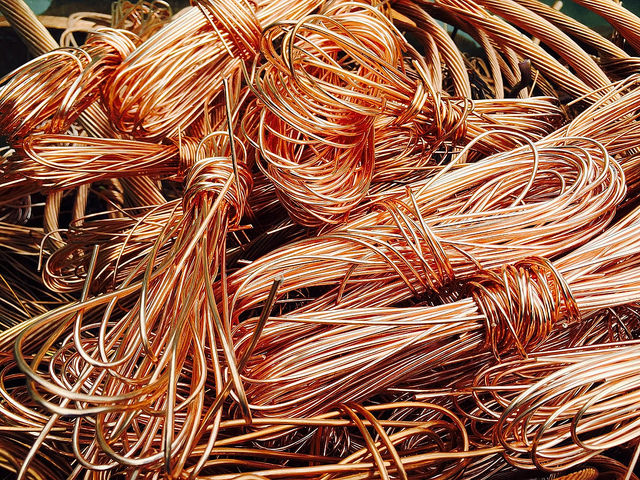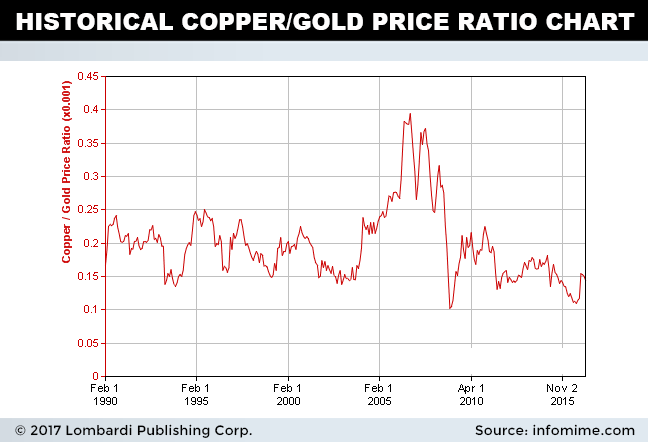High Copper Price Forecast Reflects Key Role in Corporate America’s Robotic Revolution
Copper is setting up for a big money-making opportunity brought forth by rising demand stemming from the build-out of “Industry 4.0.” That is, the phenomenon that seeks to upgrade thousands of out-of-date manufacturing facilities into modern productive wonders. And these engineering marvels utilize lots of copper. Copper prices may move quickly towards historic levels, even if the copper price forecast for next three months is subdued. For patient investors with a not-too-distant time horizon, copper could be a shining star for your portfolio.
So, what makes copper so indispensable in the drive to Industry 4.0? Quite simply, it’s the fact that copper is in everything power- or logic-based. This isn’t your normal business expansion, where copper is used in a moderate amount of piping and wiring. This expansion will be more cable-centric, with all the power requirements new-age automation needs. Copper is still the undisputed leader in affordable wiring conductivity; most everything to do with power supply, transformers, windings, and sensors will involve copious amounts of copper in the build-out. The brains behind automation logic require high concentrations of copper in the semiconductors and microprocessors that control them. Latent demand will steadily get unlocked, triggering above-trend growth over time.
Rising demand in itself is not a reliable predictor of price appreciation in isolation. However, the case for copper is one where increased demand and constrained supply conspire to create ideal conditions for future copper price trends.
Consider that copper supply may be coming into deficit for the first time in six years. This is partially the result of labor disputes, but also due to insatiable corporate American and Chinese demand, as they position themselves for the future economy. According to Citi Research, four major tailwinds are expected to work in copper’s favor for the next several years: lackluster inventories; an end to cost deflation; U.S. macro reflation; and stronger Chinese demand. Citi analysts expect supply deficits will propel copper prices in 2017 to above $6,000 a ton in the second half, and perhaps $7,000 a ton before the end of 2017. If correct, the later figure would be a cool 22.8% increase (as of prices on April 4, 2017) in just a few months. (Source: “China will help drive 33% increase in global copper prices by 2020: Citi,” CNBC, February 19, 2017.)
In fact, about nine percent of the world’s copper supply is not presently being mined due to strikes at Escondida Chile and the Grasburg mine in Indonesia. The former is the world’s largest copper producer, with supplies cut since February 7, 2017, when the strike commenced. There doesn’t appear to be a quick solution either, with both sides digging in their heels. Although these strikes will eventually get resolved—one way or another—it highlights the downside risk to copper production always looming in the background.
Top 12 Copper-Producing Nations
| Mine Production | Millions of Tons | % of World Production | % of World Production Adjusted |
|---|---|---|---|
| Chile | 5800 | 31.0% | 35.5% |
| China | 1620 | 8.7% | 9.9% |
| Peru | 1400 | 7.5% | 8.6% |
| U.S. | 1370 | 7.3% | 8.4% |
| Congo | 1100 | 5.9% | 6.7% |
| Australia | 1000 | 5.3% | 6.1% |
| Russia | 850 | 4.5% | 5.2% |
| Zambia | 730 | 3.9% | 4.5% |
| Canada | 680 | 3.6% | 4.2% |
| Mexico | 520 | 2.8% | 3.2% |
| Kazakhstan | 430 | 2.3% | 2.6% |
| Poland | 425 | 2.3% | 2.6% |
(Source: “Copper: Supply And Demand Dynamics,” CME Group, January 27, 2016.)
This is music to investors’ ears, as high copper inventories have put downward pressure on prices for several years. Not anymore, as cuts in capital expenditures have diminished the prospects of new mines contributing to supply anytime soon. In Citi’s words, this has “eviscerated” the project pipeline until 2020 at the earliest, setting copper up for the most sustained price rally since 2010. “The much-vaunted wall of supply that hit copper in 2016 failed to drown the red metal in excess supply,” the Citi note added. (Source: Ibid.)

Credits: Flickr.com/AB Corporation
Citi’s research confirms what we already know: copper stocks are not meeting expected traditional demand, let alone the added demand the technological build-out of tens of thousands of new smart factories and drones require. The low-hanging fruit has already been plucked, and “difficult” new supply is hard to get off the ground. It appears the days of significant supply glut are now permanently behind us. The future of copper prices will be predicated by scarcity, not unlimited inventories.
Another factor working in copper’s favor is the copper/gold price ratio, which is currently hovering at 0.14. This is near to its all-time data set low of 0.10 last seen at the depths of the U.S. Housing bubble. Traditionally, anything below 0.15 has provided an extremely attractive price point on which to enter. Should the ratio revert to the mean between 0.2-0.25, at today’s gold prices, copper would be valued between $8,300-10,375 a ton, an incredible premium to today’s prices.
Like the oil-to-gold ratio, the copper-to-gold ratio is an indicator of the health of the global economy. As such, it’s no surprise that it’s been trading at depressed levels for a long time. While a low ratio usually portends poorly for the health of the world economy, it’s possible that with copper supply on the downswing, the ratio could move in copper’s favor. Investors don’t need to be gung-ho on world growth prospects to take advantage of copper’s low price versus gold. Demand applications in automation, drones, electronic, and power based applications should fill in the gap.
Our copper price forecast 2017 reflects the enormous investment potential copper possesses as all these favorable dynamics take place.
Copper Price Forecast and Analysis for Q2 2017
Up until recently, the copper price forecast for Q2 was looking dandy. Prices had risen from $2.38/lb on November 8, 2016 (U.S. presidential election) to a high of $2.76/lb on February 13, 2017, for a powerful gain of 15.97% in three months. Everyone was excited about “reflation” trade, and big corporations were committed to bring manufacturing back to America. A copper deficit expectation was slowly gaining traction in the investment community.
While all true, the short-term focus has been superseded by nervousness regarding tax cuts.
When the GOP’s American Health Care Act (AHCA) died a painful death in Congress, Trump’s tax initiatives died along with it—at least temporarily. With the failure to repeal Obamacare, serious doubts have now been raised about the GOP’s ability to pass major legislation like tax reform. This was also key from the perspective that the AHCA was going to save the government $1.0 trillion; money that would be used to offset the proposed corporate tax rate drop for 35% to 20%. That plan will now have to wait, or face severe alterations.
Trump may be the stick, but he still needs the carrot to lure multinationals back and kick Industry 4.0 build-out into high gear. Copper price predictions for Q2 of 2017 may be more constrained as a result, even if the fundamental big picture hasn’t changed.
Copper Price Outlook 2017: A Changing Narrative
The three laws of robotics, as stated by legendary author and futurist Isaac Asimov, were first introduced in his 1942 story Runaround. To paraphrase, the laws state: 1) A robot must not injure a human being or allow one to come to harm; 2) A robot must obey the orders given it, except where it conflicts with the first law; 3) A robot must protect its own existence as long as it doesn’t conflict with laws one and two. With mind-blowing advances in robotic technology about to be unleashed into the workforce, laws #1 and #3 are about to clash head-on.
That’s because the mass displacement of human labor, set to ramp up exponentially, is almost upon us. Tens of millions of American workers will be “harmed” by this phenomenon, mainly through lost wages and wage depression. But if opportunity is the byproduct of invention, copper is set to capitalize through soaring demand. The first step in that process is changing the narrative that supply constraints are a reality, not the other way around.
I touched earlier on the fact that copper supply may be coming into deficit for the first time in six years. This is important from a narrative perspective because this fact is not widely appreciated. Many investors still believe that base metals like copper are in perpetual oversupply simply because they aren’t “rare.” While in much of the last 30 years this has been the case, it’s not anymore.
Consider the disconnect which has occurred with copper prices in recent years. In 2016, the International Copper Study Group published information which, contrary to the demand-side narrative, shows robust demand despite the moribund prices. It indicates that copper usage has actually been growing steadily from January 2011 to January 2016, increasing 25% during a period where copper prices fell 55%. Most of this is due to Asian hoarding of supply, but stocks held downstream haven’t grown substantially. (Source: “ICSG Statistical Database,” International Copper Study Group, last accessed April 6, 2017.)
In other words, copper prices have been suppressed by “latent” inventories, which are locked up in Asian producing nations, not a general worldwide market glut. As these huge Asian producing nations, like China, utilize their inventories, they may not be able to replenish latent inventories as easily in the coming years. This could unlock the price discovery copper so desperately needs.
As time marches forward, expect the narrative of abundant copper supply to flip to deficit. This will be key to finally breaking the invisible glass ceiling copper seems to infrequently punch through. The worldwide Industry 4.0 build-out is a major supporting factor going forward, and perhaps not fully realized. This should become apparent in time.
My copper price forecast calls for prices to touch $3.20/lb this year, especially if Trump tax cuts arrive intact and on time, and perhaps $4.00/lb copper sometime in 2018-2019 with upside potential.
Copper, the forgotten base metal no more.







